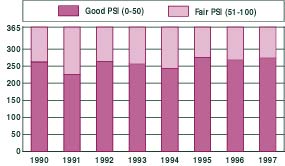To measure air quality, we used the Pollutant Standard Index (PSI). PSI is a reporting system for air quality that standardizes data for three pollutants that have implications for human and environmental health: carbon monoxide, low-level ozone and particulate matter, known as PM10. The PSI summarizes raw data from Boulder county air quality monitors. The PSI is base on the following ratings:
Air quality in Boulder County has become an issue of major concern to residents. Increasing population density and modern metropolitan living creates air pollution, which is then exacerbated by the unity, natural topography of our region. Temperature inversions in the Boulder Valley trap pollution closer to the ground, increasing the potential harm to people and the environment. The overwhelming majority of carbon monoxide (CO) pollution in our area is a direct result of automobile use. CO deprives people of necessary oxygen and particularly affects those with cardiovascular and pulmonary disease, children and pregnant women. Low-level ozone (O3) is a secondary pollutant, meaning that it is not emitted directly from one source, but arises from a chemical reaction in the presence of sunlight. Negative impacts are:
The infamous "brown cloud" is caused by concentrations of particulate matter ten micrometers (PM10) in size and smaller that are suspended in the air. PM10 results from the burning processes of power plants, cars, fireplaces and woodstoves. Human health impacts of PMS10 vary from person to person, but can negatively affect the respiratory tract. The environmental effects of particulate matter include:
According to Air Pollution Control Division, the Boulder County monitors have not exceeded the national standards for these three pollutants between 1990-1997. From 1990 to 1997, the air quality in Boulder County was categorized as either Good or Fair, with the majority of days falling into the Good rating. There were no days in which the air quality fell below the Fair rating. The average PSI from 91097 was 43. This trend appears to be holding steady. The days that our air quality fell into the lower quality PSI rating tended to occur in the Month of June and July. This indicator does not address visibility issues associated with particulate matter less than 10 micrometers in size, which has recently been identified as a problem along the Front Range. Linkages: Vehicle Miles Traveled , Land Annexation Number of Days Per Year Air Quality PSI Rating: Good
or Fair Table
of Contents/ Overview/Boulder
County at a Glance/A Vision for the Environment
/ |
